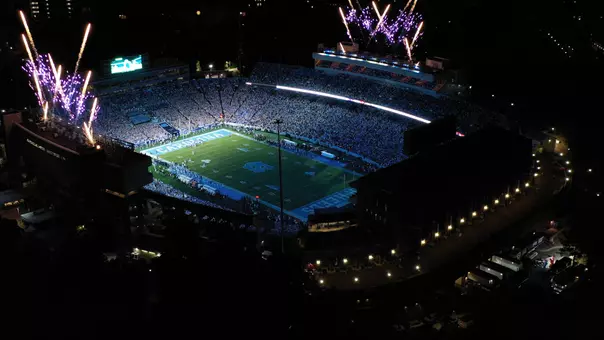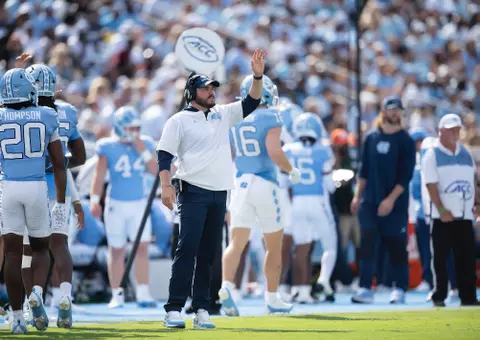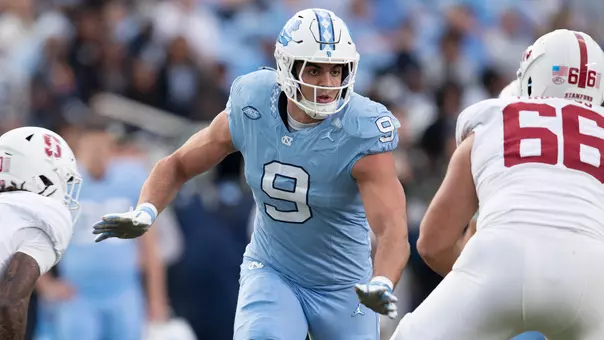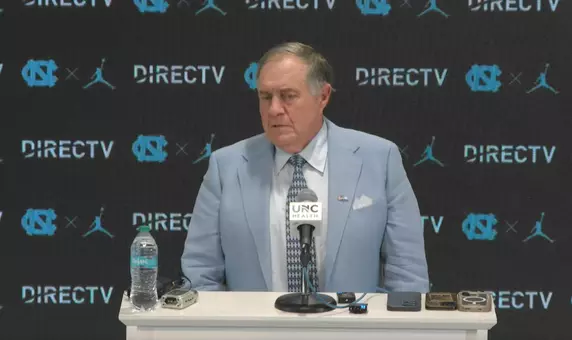University of North Carolina Athletics

Photo by: UNC Athletic Communications
Extra Points: Going Greener
March 25, 2019 | Football
By Lee Pace
Alan Caldwell remembers the early 1970s when Carolina's football team seemed to be playing more and more road games on AstroTurf. The Tar Heels had their biennial trip to Virginia and occasional forays to schools like South Carolina, Tulane and Ohio State, all of which had the early version of the light-green, hard-as-rock surface that had first been introduced at the Houston Astrodome in 1965.
"It was a whole different feel playing on turf," says Caldwell, a defensive back from 1974-77 under Coach Bill Dooley. "Coach felt if we were going to play games on turf, we should practice on turf. He lobbied for it, they raised the money and installed it at Navy Field."
One of two football practice fields has been covered with an artificial surface over these ensuing 45 years. Now, another coach has a specific set of reasons to expand the synthetic grass footprint at Carolina.
Kenan Stadium is going to synthetic grass this summer—albeit, a version of turf light years advanced from that 1970s brand—and the Tar Heels will play on it Sept. 7 when they host Miami in the home opener of Mack Brown's return as the Tar Heel coach.
The grass surface at Kenan will be torn up following commencement exercises in mid-May and a product called Rootzone 3D3 will be laid down over the next eight weeks. That's the same surface used in the new Indoor Practice Facility and being installed on one of two outdoor fields in the same location as the old Navy Field. The surface is comprised of grass-like fibers made of nylon and polyethylene with sand and rubber crumbs for infill between the fibers.
"Turf is the future because it's never been safer," Brown says. "It's softer and more forgiving and more like grass than it's ever been. We installed it at Texas, and the players loved it."
Getting a synthetic grass playing surface was one of Brown's early priorities when he took the job in late November. He remembers floating the idea about making a change in Kenan Stadium to then-Athletic Director John Swofford in the mid-1990s. But, he left for Texas for the 1998 season and found grass in Darrell K. Royal-Texas Memorial Stadium. Texas was one of the early converts to the original AstroTurf, making the change in 1967. But, the Longhorns went back to grass in 1996 after finding, like many other original proponents of AstroTurf, that it was too abrasive and too hard, and a runner's ability to achieve high degrees of traction could leave them susceptible to knee injuries.
But, the business of artificial turf made a quantum turn in 1999 with the introduction of FieldTurf, the forerunner to the product Carolina is installing. FieldTurf evolved out of a former Canadian tennis pro's business of building synthetic tennis courts for wealthy individuals. Jean Prevost's science was to take these individual blades and blend them with finely ground silica sand and recycled rubber smashed into tiny pellets. This new surface would "give" beneath a player's foot, provide some cushion when he fell and, since it wasn't built on an asphalt base, didn't generate oppressive heat in the summer. The blades were oil-coated to prevent turf burn and could be colored to look more like grass.
The first purchase in the United States was made by Nebraska AD Tom Osborne, who was so sold on FieldTurf he also became a stockholder and consultant with the company. Brown began following FieldTurf's evolution and liked the surface when the Longhorns traveled every other year to Nebraska. After the Longhorns played Texas A&M at home in the final game of the 2008 season on a wet, slippery field, Brown pushed for a turf conversion and the Longhorns began playing on synthetic grass in 2009.
"We had a consistent playing field every week and were never going to lose a game because of weather," Brown says. "It was a recruiting pitch as well. Kids love to play on a fast surface."
Then, Brown came back to Chapel Hill in late November 2018 and two weeks into his new tenure watched two high school championship games played in Kenan Stadium at the end of a long, wet fall when the Tar Heels were practicing three times a week in Kenan and playing six games there. The field was muddy and hunks of turf were dislodged, and one high school coach took to Twitter after the game to criticize the conditions.
"I had to call and apologize," Brown says. "Granted, last year was an outlier because the team practiced here all season. Still, we owe it to our high schools to have a perfect venue for their championship games. It's a once-in-a-lifetime experience for those kids. We can't have it spoiled because a team can't run its offense."
Brown reels off numerous reasons for the switch: It saves water in an emerging environment where water-usage is coming under more scrutiny; it gives AD Bubba Cunningham options on finding practice and game venues for Olympic sports during heavy usage weekends; and it prevents the football team from the time of the first autumn frost and the death of the Bermuda grass from playing on a ryegrass surface prone to being slippery even on a dry day.
"To me, it's a no-brainer," he says. "And think of that perfect green against the blue seats in the stadium. I think it will look great."
Some old-schoolers will disagree, thinking that faux grass and the natural beauty of Kenan Stadium are a contradiction. Deems May, a Tar Heel tight end in the early 1990s who went on to play eight years in the NFL, terms himself a traditionalist and favors the idea of natural grass in Kenan Stadium. But, he recognizes the advances in turf technology, that kids like it and that there are practical reasons it works. He noted that Myers Park High in Charlotte, where his daughter is a graduate (and now a freshman at Carolina) and son a freshman, is investigating a new turf field.
"When I put my hand down, I want to feel grass," May says. "I love the smell of it. My experience was brutal on turf in the NFL with turf burns. But that was more than 20 years ago, and I understand it's come a long way since. I understand where we are and the times. I'll accept it. I really get it. I don't like it, but I'll accept it."
Linemen are notorious for loving to play in the slop and muck of a bad field, but skill-position players are far more receptive to artificial turf. Receiver Beau Corrales nods toward the synthetic grass the Tar Heels are practicing on in the Indoor Practice Facility and says, "Playing on this is like home to me." One study last updated in Texas in 2017 showed that of approximately 1,200 high school stadiums in the state, just over 40 percent were artificial turf.
"I didn't play on grass from middle school until the time I came to college," Corrales says. "All of our high school game fields and our practice field were turf. I like it. On grass, you never know when you might plant and your foot slip. On turf, you know it's going to hold and you can be a little quicker on your feet."
Tailback Antonio Williams played on synthetic grass at Ohio State before transferring to Carolina and applauds the change.
"I feel like you play faster on turf," Williams says. "You can cut much better, accelerate quicker than on grass. I'm excited we're going to turf in Kenan Stadium. The more we're on turf in the indoor facility and the more guys get used to playing on turf, I think they are getting used to it and realize it will be beneficial for the team."
Offensive coordinator and QBs coach Phil Longo said he was "elated" to learn his offense will be playing on turf at least seven games a year. Longo coached three years on turf at Sam Houston State and then two years on grass at Ole Miss in recent times.
"The truth is even at Ole Miss and some of the SEC grass fields where they spend an unbelievable amount of money to take care of them and do it the right way, those fields don't stay in good enough condition all season to where it doesn't affect performance," he says. "And they're doing it the right way. It's just difficult. My view is, why train for 365 days a year to get everything just right and then have your field and weather conditions affect the outcome of a game?
"I've seen the same offense with great athletes on two different surfaces, and I know there is so much more to overcome on grass. It makes a huge difference."
Three of six northernmost schools in the SEC play on synthetic surfaces—Kentucky, Vanderbilt and Missouri. All have latitudes roughly similar to Chapel Hill, with good growing conditions the early part of the fall but more trouble after October.
Kentucky replaced the natural grass surface at Commonwealth Stadium with FieldTurf prior to the 2015 season. "We want to play with tempo, play fast and want a consistent surface that looks good all the time," Coach Mark Stoops said.
Carolina will be the only school in the ACC Coastal Division with a synthetic grass field. But as Corrales says, "At the end of the day, we're playing football so it doesn't affect us too much. I'm more worried about making plays than the surface we're playing on."
Alan Caldwell is like Deems May in the fraternity of former Tar Heels: His druthers would keep grass in Kenan Stadium, but if synthetic grass is for the greater good, so be it.
"If turf helps us win and helps Coach Brown get this program back to where it belongs, I'm fine with that," Caldwell says.
Chapel Hill writer Lee Pace has been covering Tar Heel football with his "Extra Points" column since 1990 and in 2016 published the definitive history of Kenan Stadium, "Football in a Forest." Follow him @LeePaceTweet and write him at leepace7@gmail.com
Alan Caldwell remembers the early 1970s when Carolina's football team seemed to be playing more and more road games on AstroTurf. The Tar Heels had their biennial trip to Virginia and occasional forays to schools like South Carolina, Tulane and Ohio State, all of which had the early version of the light-green, hard-as-rock surface that had first been introduced at the Houston Astrodome in 1965.
"It was a whole different feel playing on turf," says Caldwell, a defensive back from 1974-77 under Coach Bill Dooley. "Coach felt if we were going to play games on turf, we should practice on turf. He lobbied for it, they raised the money and installed it at Navy Field."
One of two football practice fields has been covered with an artificial surface over these ensuing 45 years. Now, another coach has a specific set of reasons to expand the synthetic grass footprint at Carolina.
Kenan Stadium is going to synthetic grass this summer—albeit, a version of turf light years advanced from that 1970s brand—and the Tar Heels will play on it Sept. 7 when they host Miami in the home opener of Mack Brown's return as the Tar Heel coach.
The grass surface at Kenan will be torn up following commencement exercises in mid-May and a product called Rootzone 3D3 will be laid down over the next eight weeks. That's the same surface used in the new Indoor Practice Facility and being installed on one of two outdoor fields in the same location as the old Navy Field. The surface is comprised of grass-like fibers made of nylon and polyethylene with sand and rubber crumbs for infill between the fibers.
"Turf is the future because it's never been safer," Brown says. "It's softer and more forgiving and more like grass than it's ever been. We installed it at Texas, and the players loved it."
Getting a synthetic grass playing surface was one of Brown's early priorities when he took the job in late November. He remembers floating the idea about making a change in Kenan Stadium to then-Athletic Director John Swofford in the mid-1990s. But, he left for Texas for the 1998 season and found grass in Darrell K. Royal-Texas Memorial Stadium. Texas was one of the early converts to the original AstroTurf, making the change in 1967. But, the Longhorns went back to grass in 1996 after finding, like many other original proponents of AstroTurf, that it was too abrasive and too hard, and a runner's ability to achieve high degrees of traction could leave them susceptible to knee injuries.
But, the business of artificial turf made a quantum turn in 1999 with the introduction of FieldTurf, the forerunner to the product Carolina is installing. FieldTurf evolved out of a former Canadian tennis pro's business of building synthetic tennis courts for wealthy individuals. Jean Prevost's science was to take these individual blades and blend them with finely ground silica sand and recycled rubber smashed into tiny pellets. This new surface would "give" beneath a player's foot, provide some cushion when he fell and, since it wasn't built on an asphalt base, didn't generate oppressive heat in the summer. The blades were oil-coated to prevent turf burn and could be colored to look more like grass.
The first purchase in the United States was made by Nebraska AD Tom Osborne, who was so sold on FieldTurf he also became a stockholder and consultant with the company. Brown began following FieldTurf's evolution and liked the surface when the Longhorns traveled every other year to Nebraska. After the Longhorns played Texas A&M at home in the final game of the 2008 season on a wet, slippery field, Brown pushed for a turf conversion and the Longhorns began playing on synthetic grass in 2009.
"We had a consistent playing field every week and were never going to lose a game because of weather," Brown says. "It was a recruiting pitch as well. Kids love to play on a fast surface."
Then, Brown came back to Chapel Hill in late November 2018 and two weeks into his new tenure watched two high school championship games played in Kenan Stadium at the end of a long, wet fall when the Tar Heels were practicing three times a week in Kenan and playing six games there. The field was muddy and hunks of turf were dislodged, and one high school coach took to Twitter after the game to criticize the conditions.
"I had to call and apologize," Brown says. "Granted, last year was an outlier because the team practiced here all season. Still, we owe it to our high schools to have a perfect venue for their championship games. It's a once-in-a-lifetime experience for those kids. We can't have it spoiled because a team can't run its offense."
Brown reels off numerous reasons for the switch: It saves water in an emerging environment where water-usage is coming under more scrutiny; it gives AD Bubba Cunningham options on finding practice and game venues for Olympic sports during heavy usage weekends; and it prevents the football team from the time of the first autumn frost and the death of the Bermuda grass from playing on a ryegrass surface prone to being slippery even on a dry day.
"To me, it's a no-brainer," he says. "And think of that perfect green against the blue seats in the stadium. I think it will look great."
Some old-schoolers will disagree, thinking that faux grass and the natural beauty of Kenan Stadium are a contradiction. Deems May, a Tar Heel tight end in the early 1990s who went on to play eight years in the NFL, terms himself a traditionalist and favors the idea of natural grass in Kenan Stadium. But, he recognizes the advances in turf technology, that kids like it and that there are practical reasons it works. He noted that Myers Park High in Charlotte, where his daughter is a graduate (and now a freshman at Carolina) and son a freshman, is investigating a new turf field.
"When I put my hand down, I want to feel grass," May says. "I love the smell of it. My experience was brutal on turf in the NFL with turf burns. But that was more than 20 years ago, and I understand it's come a long way since. I understand where we are and the times. I'll accept it. I really get it. I don't like it, but I'll accept it."
Linemen are notorious for loving to play in the slop and muck of a bad field, but skill-position players are far more receptive to artificial turf. Receiver Beau Corrales nods toward the synthetic grass the Tar Heels are practicing on in the Indoor Practice Facility and says, "Playing on this is like home to me." One study last updated in Texas in 2017 showed that of approximately 1,200 high school stadiums in the state, just over 40 percent were artificial turf.
"I didn't play on grass from middle school until the time I came to college," Corrales says. "All of our high school game fields and our practice field were turf. I like it. On grass, you never know when you might plant and your foot slip. On turf, you know it's going to hold and you can be a little quicker on your feet."
Tailback Antonio Williams played on synthetic grass at Ohio State before transferring to Carolina and applauds the change.
"I feel like you play faster on turf," Williams says. "You can cut much better, accelerate quicker than on grass. I'm excited we're going to turf in Kenan Stadium. The more we're on turf in the indoor facility and the more guys get used to playing on turf, I think they are getting used to it and realize it will be beneficial for the team."
Offensive coordinator and QBs coach Phil Longo said he was "elated" to learn his offense will be playing on turf at least seven games a year. Longo coached three years on turf at Sam Houston State and then two years on grass at Ole Miss in recent times.
"The truth is even at Ole Miss and some of the SEC grass fields where they spend an unbelievable amount of money to take care of them and do it the right way, those fields don't stay in good enough condition all season to where it doesn't affect performance," he says. "And they're doing it the right way. It's just difficult. My view is, why train for 365 days a year to get everything just right and then have your field and weather conditions affect the outcome of a game?
"I've seen the same offense with great athletes on two different surfaces, and I know there is so much more to overcome on grass. It makes a huge difference."
Three of six northernmost schools in the SEC play on synthetic surfaces—Kentucky, Vanderbilt and Missouri. All have latitudes roughly similar to Chapel Hill, with good growing conditions the early part of the fall but more trouble after October.
Kentucky replaced the natural grass surface at Commonwealth Stadium with FieldTurf prior to the 2015 season. "We want to play with tempo, play fast and want a consistent surface that looks good all the time," Coach Mark Stoops said.
Carolina will be the only school in the ACC Coastal Division with a synthetic grass field. But as Corrales says, "At the end of the day, we're playing football so it doesn't affect us too much. I'm more worried about making plays than the surface we're playing on."
Alan Caldwell is like Deems May in the fraternity of former Tar Heels: His druthers would keep grass in Kenan Stadium, but if synthetic grass is for the greater good, so be it.
"If turf helps us win and helps Coach Brown get this program back to where it belongs, I'm fine with that," Caldwell says.
Chapel Hill writer Lee Pace has been covering Tar Heel football with his "Extra Points" column since 1990 and in 2016 published the definitive history of Kenan Stadium, "Football in a Forest." Follow him @LeePaceTweet and write him at leepace7@gmail.com
Players Mentioned
MBB: Hubert Davis Post-ETSU Press Conference
Wednesday, December 17
Carolina Insider: Rapid Reactions pres. by Modelo – Men’s Basketball vs. ETSU – December 16, 2025
Wednesday, December 17
UNC Men's Basketball: Veesaar's Career High Leads 77-58 Win Over ETSU
Wednesday, December 17
WBB: Post-Louisville Press Conference - December 14, 2025
Monday, December 15
















